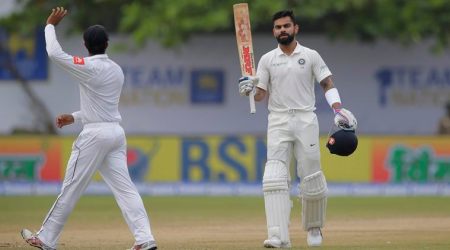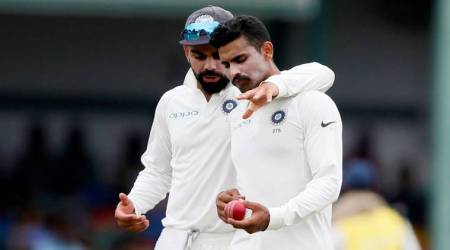 After the sapping heat of Galle and Colombo, India will be happy to be in the hill country of Kandy. (Source: Express photo by Sandip G)
After the sapping heat of Galle and Colombo, India will be happy to be in the hill country of Kandy. (Source: Express photo by Sandip G)
Both the sights and climes of Kandy, the venue for the third and final Test between Sri Lanka and India, would please Virat Kohli and his men. Right in the middle of the central Sri Lankan highlands, Kandy sits at over 1600 feet above the Indian Ocean in a valley beside a placid lake. The weather, therefore, is agreeable – a mild breeze wafts through the stadium and it almost feels like a mid-March afternoon in Delhi. There has been a bit of a drizzle, but unlike coastal Sri Lanka, there’s not the sweltering mugginess, which expends the sweat glands even if you aren’t physically engaged, that accompanies a spell of rain.
It’s such a stark – and welcome – contrast from the two other venues India have played on this tour.
Galle was quaint, the waves and the fort rendering a bizarre beauty. Colombo was its diametric opposite, a buzzing metropolis that lacks warmth. But both cities had one common thread, the sweeping humidity. Every burst of rain brought with it an attendant wave of humidity. The sun’s so scorching that you feel as if you’re being burnt alive.
Then what about the players out in the middle?
It’s a widely understated, or ignored, factor when India – or any other subcontinental side – tours Sri Lanka. The common refrain is, “it’s just like home”. Similar physical traits, cuisine and climate. But similarity doesn’t necessarily translates into comfort, especially the stifling post-monsoon heat, which most Indian cricketers, barring maybe Ravichandran Ashwin, are so unaccustomed to.
No wonder then that the Indian players were visibly upset at the location of the press conference room at the Sinhalese Sport Club. They had to climb four flights of stairs after each day’s play. So much so that Ashwin, wiping sweat off the brow, quipped when asked about the difficulty of bowling in the heat: “It was definitely better than climbing four floors.” The same day, centurion Kusal Mendis was so tired that he flunked the press conference, and instead came Niroshan Dickwella, who had batted just an hour or two in the first session.
Tucked around Ashwin’s waist was a white towel with red blotches, which he used not only to rub the ball but also keep his fingers dry. It was perhaps a reason none of the seamers, including the master of it Mohammed Shami, could procure reverse swing in Colombo, as it’s immensely difficult to run the fingers down on the ball.
Even the umpires sympathised with the players and allowed more impromptu drinks breaks than usual. The stipulated drinks interval, too, would drag on. The batsmen would frequently signal for a fresh pair of gloves. En route to his hundred at the SSC, Cheteshwar Pujara must have changed his gloves at least half a dozen times. Having faced 532 balls, more than any other batsman in the series, he must have felt the heat more than most. As soon as the spinners would begin to bowl, the batsmen would banish their helmets. It’s easy to imagine Rahul Dravid batting in these conditions, perspiring profusely, beads of sweat dripping down the helmet grille and him frequently changing the sweat-drenched neck-ties and gloves.
Understandably, the fast bowlers were most often used in bursts of four or five overs. It was an aspect Virat Kohli had stressed in the pre-series press conference: “In these conditions, you should be very realistic about how many overs a bowler can bowl in a spell. Fast bowlers, at best, should be used in short spells of four-five.” Anything more will tire them, like it did Hardik Pandya in the second innings at SSC, wherein after his fourth over he became entirely stingless.
To keep them hydrated, the entire squad players, and sometimes even the masseurs, rove around the boundary rope with a casket of refreshments. But no matter how much fluid you put into the players, it drains out very quickly. At stumps, the sight of players dragging themselves to the dressing room evokes the image of a wind-beaten battalion retreating to its barracks.
The infernal conditions influenced the tactics of the skippers, too. Kohli didn’t enforce the follow-on in Galle as he felt the bowlers “would be too tired”. But in Colombo, since they had bowled only 49.4 overs in less trying conditions, Kohli decided to make Sri Lanka bat again. Though both Tests ended in four days, the players might feel they were just back from a timeless Test.
It’s such conditions that make overseas sides dread a trip to Sri Lanka, despite its exotic beauty. When England toured here in 2001, the players wore Arctic Ice vests to negate heatstroke and exhaustion as the temperature in the middle soared above 40 degrees with 80 per cent humidity. The England players were weighed three times a day, wore sun-block neckties and were given cold showers and towels when they came off the pitch. And some of the stockier players returned home with thinner frames. There are also stories of players collapsing and being rushed for saline drips.
The heat sparked BBC commentator Jonathan Agnew’s wit, too. “It’s red hot on the field, it’s red hot in the dressing room and what do you get for lunch? Red-hot curry,” he once said. It wouldn’t be surprising if some of the Indians players too feel the same.
But at least, the humidity is less of a factor at this time of the year in the high hill country of Kandy, which has experienced a drier weather than usual. For Kohli and Co, the series already pocketed, it could be like an excursion to the hills.

